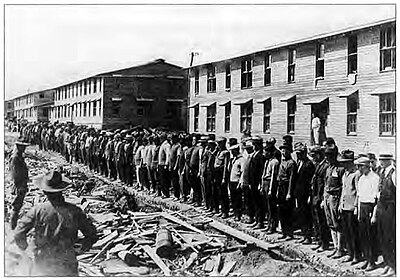
Draftees drill in civilian clothes, Camp Upton, New York.
The 3d through the 8th Divisions, Regular Army units, were organized between 21 November 1917 and 5 January 1918 in the United States. Of these divisions, only the 4th and 8th assembled and trained as units before going overseas because the Guard and National Army units occupied the divisional training areas. The 4th replaced the 41st Division at Camp Greene, and the 8th occupied Camp Fremont upon its completion. To fill the divisions, partially trained draftees were transferred from National Army units, a process that eroded the concept of the three separate components—the Regular Army, the National Guard, and the National Army.[1]
As the three-component idea deteriorated, Baker discussed the elimination of such distinctions altogether with Scott and Bliss. The officers opposed the action, believing it would undermine the local pride that National Guard and National Army units exhibited. General Peyton C. March, who had served as Army Chief of Staff since the spring of 1918, disagreed. He announced that the nation had but one army, the United States Army, and discontinued the distinctive names and insignia for the three components. After 7 August 1918, all soldiers, including those in divisions, wore the collar insignia of the United States Army. Nevertheless, the men still considered their divisions as belonging to the Regular Army, the National Guard, or the National Army.[2]
All-black units comprised a special category of troops. The draft of the
